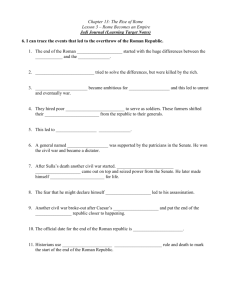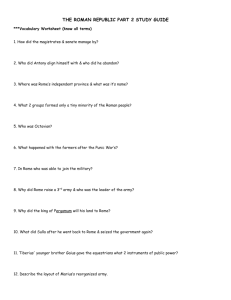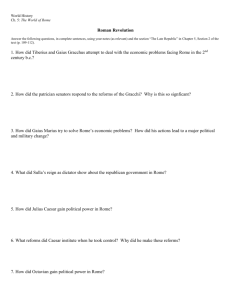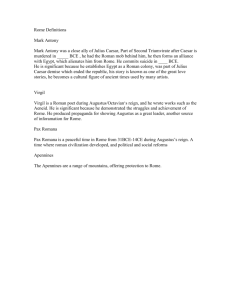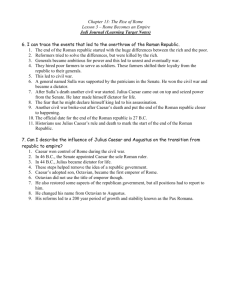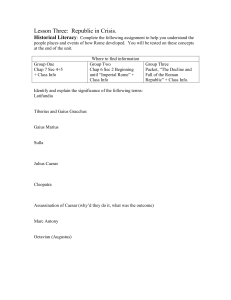The Roman Empire
advertisement
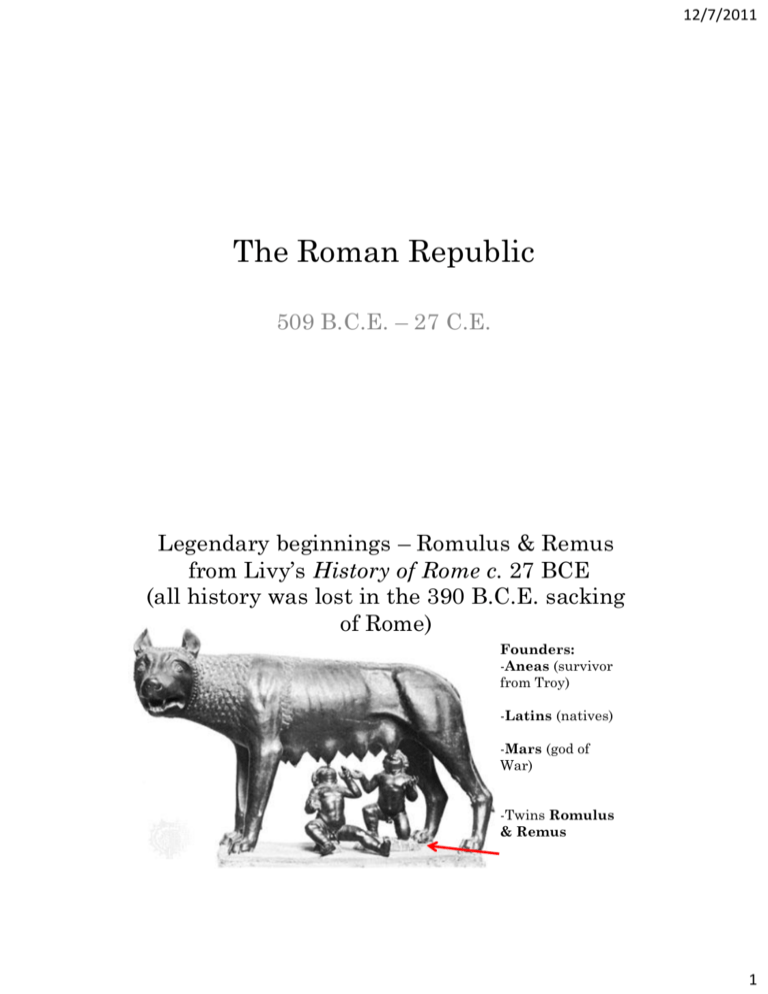
12/7/2011 The Roman Republic 509 B.C.E. – 27 C.E. Legendary beginnings – Romulus & Remus from Livy’s History of Rome c. 27 BCE (all history was lost in the 390 B.C.E. sacking of Rome) Founders: -Aneas (survivor from Troy) -Latins (natives) -Mars (god of War) -Twins Romulus & Remus 1 12/7/2011 Real Beginnings • The Etruscans (purple) • Latins (green) • Greeks (pink) • Carthaginians (light orange) • Rest: other tribal peoples Below: Defensive Walls & armor Etruscans 800 B.C.E. • Militarily stronger than natives. • Greek sources paint them as immoral due to gender equality. •Rome adopted Etruscan religion (use of auguries), military organization, art forms & architecture. 2 12/7/2011 Roman Natives (Latins) • 800 B.C.E: Iron Age Huts along Tiber River. • By 509 B.C.E.: Etruscan style fortresses on top of hills – Romulus built his city on Palatine Hill. – Etruscans drained the swamp land around Rome, made Rome into a real city! Greeks • 8th c. B.C.E.: Greek Poleis formed in Italy – Early Hellenic Age • 6th c. B.C.E.: Romans gain independence; Hellenic influence grew. • 4th c. B.C.E.: The Hellenistic Age began – spreading culture through Alexandria, Athens, Antioch, etc.. Above: Greek temple in Southern Italy Below: Greek Amphitheater in S. Italy • 2nd c. B.C.E.: Romans conquered Greece. Hellenistic Influence grew. • “The name Greek is no longer a mark of a race, but of an outlook, and is accorded to those who share our culture rather than our blood.” - Isokrates in 380 BCE. 3 12/7/2011 Carthage • 8th c. B.C.E.– founded by Phoenicians – – – – Dominated W. Mediterranean Trade. Traded with the Romans. Some Carthaginians lived in Rome. May have also influenced Roman religious practices. • 2nd c. B.C.E. - Conquered by Rome – Wars solidified Rome’s military – Built a Navy based on a Carthaginian ship. Carthaginian Empire in Blue Above – Carthaginian Harbor The Rise of Rome • 509 B.C.E.: Expulsion of the Etruscan Kings. • Formation of the Roman Republic (Res Publica) Old, wealthy, landowning families, military leaders, priests. Then, by birth. Patricians 5-10% Plebeians 90-95% See the ORANGE slide for the Republic 4 12/7/2011 The 12 Tables 450 B.C.E. The first Roman Law Code Laws were held secretly by the Patricians & Plebeians were severely punished until the 12 Tables were created. On Debt "When a debt has been acknowledged or a judgment has been pronounced in court, 30 days must be the legitimate grace period. Thereafter, arrest of the debtor may be made... Bring him into court. If he does not satisfy the judgment …the creditor may take the debtor with him. He may bind him either in stocks or fetters, with a weight of no less than 15 lbs. (or more if he desires)." [After 60 days in custody, the case is returned to the court, and if the debt is not then paid, the debtor can be sold abroad as a slave, or put to death.] On Theft & Self Defense “If the theft has been done by night, if the owner kills the thief, the thief shall be held to be lawfully killed.” “It is unlawful for a thief to be killed by day....unless he defends himself with a weapon; even though he has come with a weapon, unless he shall use the weapon and fight back, you shall not kill him. And even if he resists, first call out so that someone may hear and come up.” The 12 Tables 450 B.C.E. The first Roman Law Code On Family “A dreadfully deformed child shall be killed.“ "Our ancestors saw fit that females, by reason of levity of disposition, shall remain in guardianship, even when they have attained their majority.“ “If a man and woman live together continuously for a year, they are considered to be married; the woman legally is treated as the man's daughter.” “A child born after ten months since the father's death will not be admitted into a legal inheritance” “Marriage shall not take place between a patrician and a plebeian.” Class conflict would continue to be a problem through the long history of Rome 5 12/7/2011 The Roman Republic Monarchy Branch Aristocracy Branch Democracy Branch 2 Consuls Dictator for emergencies – 6 months only. Senate General Assembly; led by 10 powerful Tribunes Originally Patricians only Patricians only Plebeians only -1 year term. Had to wait 10 years before serving again. Had most of the power Fought for more rights for 200 years, but became a rubber stamp. -Could veto each other. -1 led army; 1 led civil gov’t -Tribunes answer to them. -Intro ambassadors to Senate -Propose laws to Senate & report laws to assembly -All preparations for war -Managed the treasury -Approved spending by Consuls -Prosecutors for criminal trials -Proposed treaties with foreign powers -Declared War -Decides which ambassadors to see. -Decides how Consuls will be treated after wars. -Chose Tribunes -Act as judge & jury in criminal trials. -Only group who could impose the death sentence. -Could approve or reject laws. -Could approve or reject peace treaties. -Could approve or reject declarations of war. The Growth of Rome • Ancient Rome: Expansion & Conquest Movie Guide – Question for Consideration after the film, based on last night’s reading: After conquering so many people, how did Rome manage to hold the empire together? In other words, why didn’t conquered people rebel against Rome? 6 12/7/2011 The Decline of the Republic • Senatorial Murder – 133 & 121 B.C.E.: Tiberius & Gaius Gracchus, brothers, grandsons of Scipio Africanus, murdered by Senate (with 100s-1000s of their supporters) for trying to help the poor/ accused of trying to gain support to be king. • Wanted to get land back for soldiers who lost it due to long campaigns. • Wanted to regulate the price of grain. • Rise of long term Dictators – 107 B.C.E.: Gaius Marius allows the poor to serve in the military, pays them, provides weapons, provides a pension (land) for 20 yrs. Service. Military becomes loyal to HIM, not the state. Marius went on to become Consul 6 times. The Decline of the Republic • Civil Wars – 91-88 B.C.E. The Social Wars • Italian Allies revolt over citizenship issues. • Politics divides: Optimates vs. Populares – 88-82 B.C.E. Gaius Marius vs. Sulla • Marius = too old to lead an army. Sulla = young brilliant general – When Marius tried to take a legion away from Sulla to lead the military himself, Sulla marched on Rome. – CIVIL WAR. – Sulla appointed dictator. Executed enemies of the state (c. 9000 people). Exiled others. – Spared Julius Caesar (related to Marius & supporters of his) – “There were many a Marius in Caesar” – 59-53 B.C.E.: First Triumvirate. • Caesar - Pompey - Crassus 7 12/7/2011 The Decline of the Republic • Civil War & the Dictatorship of Caesar – 49-48 B.C.E.: Julius Caesar vs. Pompey – 48 B.C.E.: Julius Caesar named Dictator. 11 days later, appointed as Consul. • Pompey Killed in Alexandria (head on a silver platter) • Caesar creates the Julian Calendar (365 days, leap year, July named for him). Spends tons of money on public works angering senators. – 45 B.C.E. Caesar coins money with his image & “Dictator in perpetuity” on it. – March 14, 44 B.C.E: Caesar Murdered in Senate Senate : “People of Rome, we are free once again” • 44 -36 B.C.E. Octavian vs. Enemies of Caesar • 41 – 30 B.C.E. Octavian vs. Mark Antony. • 27 B.C.E. Octavian called Augustus Caesar Augustus Caesar – First Emperor of Rome • The Republic became a rubber stamp for the true leader of Rome. • The Republic was dead. 8
